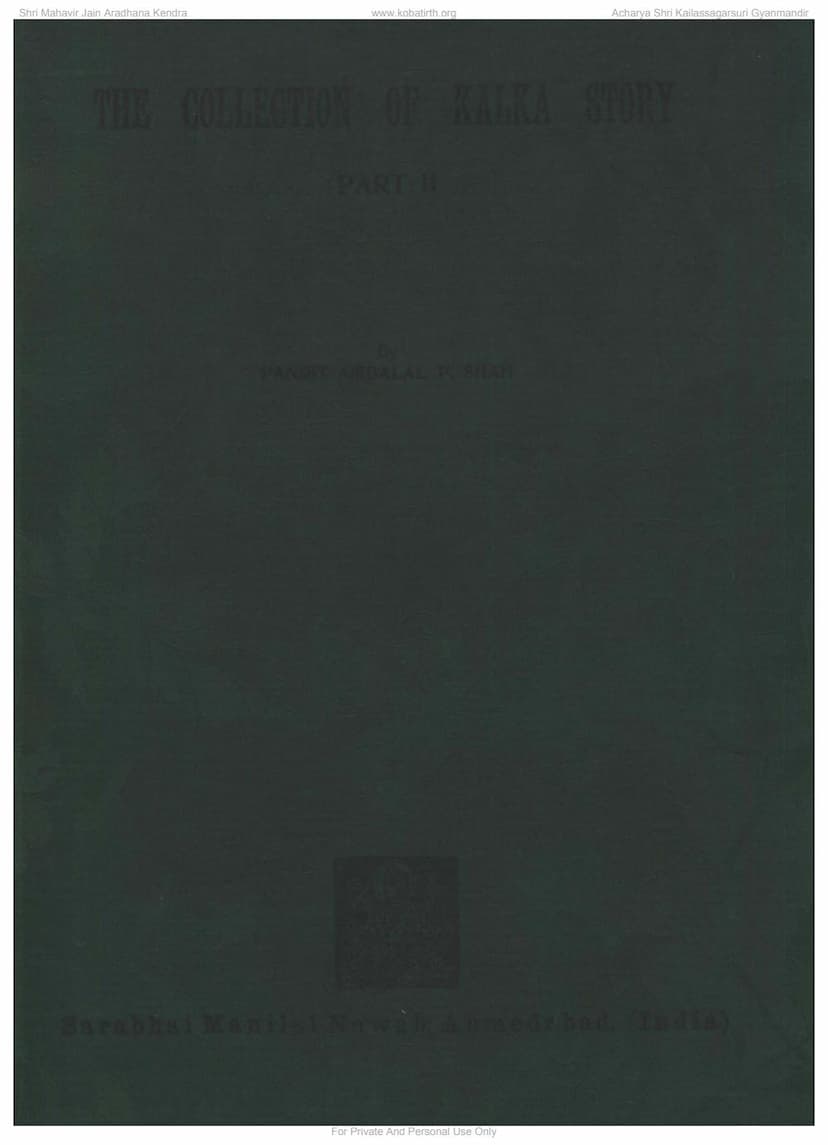Collection Of Kalka Story Part 02
Added to library: September 1, 2025

Summary
This document is the second part of "The Collection of Kalka Story," compiled by Pandit Ambalal P. Shah and published by Sarabhai Manilal Nawab in Ahmedabad in 1949. It is part of the Sri Jain Kala Sahitya Samsodhan Series. This particular volume, Part II, focuses on collecting and presenting various versions of the "Kalikaacharya Katha" (Story of Kalikacharya) from different Jain scriptures and traditions.
The book is meticulously organized into three main sections:
Section I: Kalaka Story from Jain Scriptures This section draws narratives about Kalaka Acharya from foundational Jain texts, including:
- Nisithacurni's Katha: Attributed to Sri Jinadāsamahattara.
- Brihatkalpabhasya's Katha: Attributed to Sri Sanghadāsagaņi.
- Brihatkalpacurni's Kathā
- Vyavahāracurņi's Katha
- Avashyakasūtracurņi's Kathā: Attributed to Sri Jinadāsamahattara.
- Dashacūrņi's Katha
Section II: Prakrta Stories This section presents versions of the Kalikaacharya narrative written in Prakrit, featuring contributions from:
- Mulasudditika's Katha: By Sri Devacandrasuri.
- Pushpamala's Kathā: By Maladhāri Sri Hemacandrasūri.
- Kathavali's Kathā: By Sri Bhadreśvarasuri.
- Kalikacāryakathā: By Ajnātasūri (multiple versions).
- Kālakasūrikathā: By Sri Dharmaghoṣasūri.
- Other versions attributed to Sri Bhāvadevasūri, Sri Dharmaprabhasuri, Sri Vinayacandrasuri, Sri Jayānandasūri, and Sri Kalyāṇatila kagani.
Section III: Sanskrit-Old-Gujarati Stories This section includes versions of the story in Sanskrit and Old Gujarati, with attributions to:
- Sri Devendrasūri
- Sri Rāmabhadra
- Sri Vinayacandra
- Sri Maheśvarasūri
- Sri Prabhācadrasūri
- Ajnātasūri (multiple versions)
- Sri Jinadevasūri
- Sri Māņikyasūri
- Sri Devakllolamuni
- Sri Samayasundaragani
- Maladhāri Sri Hemacandracārya
- Sri Subhasīlagaņi
- Sri Dharmadāsgaņi
- Sri Somasundaragani
- Sri Rāmacandrasuri
- Srī Gunaratnasūri
Key Themes and Narratives:
The collection, drawing from various sources, consistently highlights Kalikacharya as a pivotal figure in Jain history, renowned for his learning, miraculous powers, and strategic actions. A central narrative thread across many versions involves:
- The Tyranny of King Gardabhilla: The stories often begin with the oppressive reign of King Gardabhilla of Ujjain, who, due to his misdeeds or the influence of a powerful courtesan/sorceress (often depicted as a prostitute named Gardabhī), persecutes the Jain community or a specific Jain nun.
- Kalikacharya's Intervention: In response to this injustice, Kalikacharya, often depicted as having supernatural abilities (like commanding divine beings or performing miracles), takes action.
- The Conquest of Ujjain: Kalikacharya, using his wisdom and powers, devises a plan to defeat Gardabhilla. This often involves clever tactics, such as feigning madness, using divine intervention, or even employing earthly means to outwit the king. He ultimately leads an army, often comprising allied kings or supernatural forces, to conquer Ujjain, liberate the oppressed, and restore righteousness.
- The Establishment of the Fourth Day of Paryushan: One of the significant historical accounts linked to Kalikacharya is his role in establishing the observance of Paryushan (a Jain festival of repentance and fasting) on the fourth day of the lunar fortnight, rather than the usual fifth day. This is often presented as a concession made to a pious king (like Shalivahana) who needed the fifth day for a festival of Indra, thus integrating important religious observances.
- The Story of Sarassati: A recurring narrative involves the abduction or persecution of Sarasvati, Kalikacharya's sister or a prominent Jain nun, by Gardabhilla, which serves as a catalyst for Kalikacharya's decisive action.
- The "Gardabhī" Power: Gardabhilla is often depicted as possessing a powerful magical ability, symbolized by the "Gardabhī" (she-donkey), which emits a sound that incapaculates anyone who hears it. Kalikacharya's strategy often involves neutralizing this power.
The collection showcases the richness and diversity within Jain tradition regarding historical narratives and the veneration of significant Acharyas like Kalikacharya. The various recensions and variations highlight different literary styles, the evolution of the narrative over centuries, and the importance of Kalikacharya's legend in Jain history and practice. The inclusion of attributions to specific authors and texts emphasizes the scholarly approach to preserving and presenting this important tradition.